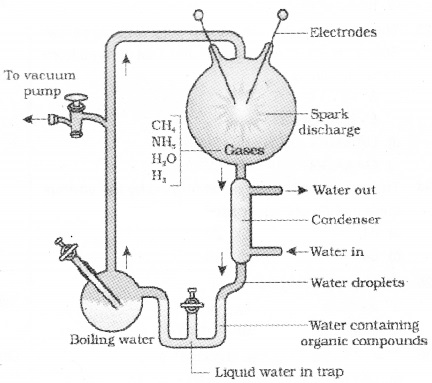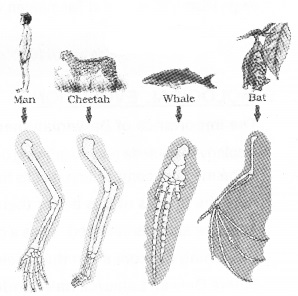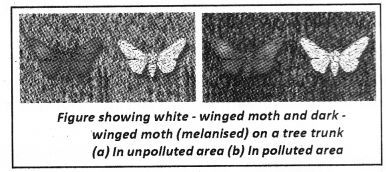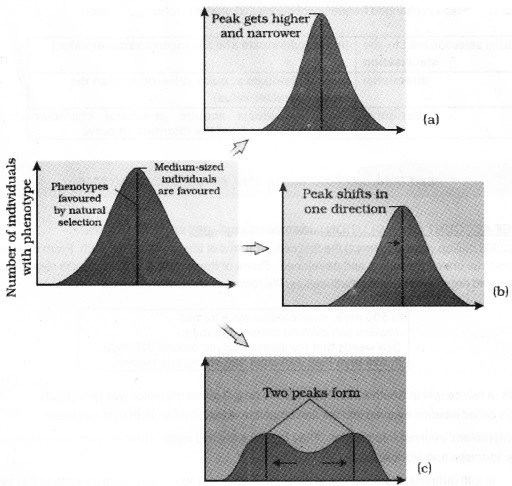Plus Two Zoology Notes Chapter 5 Evolution is part of Plus Two Zoology Notes. Here we have given Plus Two Zoology Notes Chapter 5 Evolution.
| Board | SCERT, Kerala |
| Text Book | NCERT Based |
| Class | Plus Two |
| Subject | Zoology Notes |
| Chapter | Chapter 5 |
| Chapter Name | Evolution |
| Category | Plus Two Kerala |
Kerala Plus Two Zoology Notes Chapter 5 Evolution
Origin Of Life
In the solar system, earth was originated 4.5 billion years back. There was no atmosphere on early earth.
| Water vapour, methane, carbondioxide and ammonia are found on the surface |
The UV rays from the sun broke up water into Hydrogen and Oxygen. Oxygen combined with ammonia and methane to form water, CO2 and others.
Life originated four billion years. Earlier it was believed that life originated from non living things. This is the theory of spontaneous generation.
Later Louis Pasteur demonstrated that life comes only from pre-existing life. He showed that in presterilised flasks, life did not come from killed yeast while in another flask open to air, new living organisms arose from ‘killed yeast’.
Oparin and Haldane proposed that the first form of life that arose from pre-existing non-living organic molecules (e.g. RNA, protein, etc.) and it is followed by chemical evolution.
In 1953, S.L. Miller, an American scientist created similar conditions in a laboratory He created electric discharge in a closed flask containing CH4, H2, NH3 and water vapaur at 800°C. He observed the formation of amino acids.
The first non-cellular forms of life could have originated 3 billion years back i.e RNA, Protein, Polysaccharides, etc…
Later the first cellular forms (single-celled) were originated. These were occurred in water environment only.
Diagrammatic Representation of Miller’s Experiment:

Evolution Of Life Forms – A Theory
Charles Darwin has conducted a voyage ship called H.M.S. Beagle round the world and reach the conclusion that existing living forms share similarities not only among themselves but also with life forms that existed millions of years ago. There has been gradual evolution of life forms.
According to the concept of reproductive fitness, those who are better fit in an environment, produce more progeny than others and survived more. He called it as natural selection an important mechanism of evolution.
In the same time Alfred Wallace naturalist of Malay Archepelago had the same conclusion as Darvin, that all the existing life forms share similarities and share common ancestors.
What Are The Evidences For Evolution?
Evidence of evolution of life comes from fossils that found in sedimentary rocks. Different-aged rock sediments contain fossils of different life-forms. They represent extinct organisms (e.g., Dinosaurs).This type of evidence is called paleontological evidence.
Analysing the comparative anatomy and morphology, shows similarities and differences among organisms of today and those that existed years ago.

Example of homologous organs in (a) Plants and (b) Animals:

For example whales, bats, Cheetah and human share similarities in the pattern of bones of forelimbs (similar anatomical structure).
It contains the bones like humerus, radius, ulna, carpals, metacarpals and phalanges. The same structure developed along different directions due to adaptions to different needs. So they have different functions.
These structures are homologous. This type of evolution is called divergent evolution. Other examples are vertebrate hearts or brains and the thorn and tendrils of Bougainvillea.
Wings of butterfly and of birds anatomically dissimilar but they perform similar functions. These are analogous structures arise due to convergent evolution.
Other examples are the eye of the octopus and of mammals or the flippers of Penguins and Dolphins: Sweet potato (root modification) and potato (stem modification) etc.

Another evidence supporting evolution by natural selection comes from England. Before industrialisation there are more white-winged moths on trees than dark-winged.
This is due to white-coloured lichen covered the trees – in that background the white winged moth survived But after industrialisation, there were more dark-winged moths in the same area because the tree trunks became dark due to industrial smoke and soots.
Under this condition the white-winged moth did not survive due to predators, dark-winged or melanised moth survived.
Lichen are pollution indicators they cannot grow in areas that are polluted. Hence, moths that were able to camouflage themselves.
What Is Adaptive Radiation?
In this, the small black birds -Darwin’s Finches are examples. Darwin found that there were many varieties of finches in the same island.
Their original seed-eating features are changed and become insectivorous and Variety of beaks of finches that Darwin found in Galapagos Island vegetarian finches.
Here the evolution starting from a point and radiating to other areas of geography (habitats) is called adaptive radiation.
Another example is Australian marsupials. A number of different marsupials evolved from an ancestral stock within the Australian island.
Placental mammals in Australia also exhibit adaptive radiation i.e they evolved into varieties (e.g., Placental wolf and Tasmanian wolf marsupial).
Variety of beaks of finches that Darwin found in Galapagos Island:

Biological Evolution
The importance of Darwinian theory of evolution lies in natural selection.
A colony of bacteria (say A) growing on a given medium show variation in terms of feed component. A change in the medium composition results the population (say B) that can survive under the new conditions.
Here the fitness of B is better than that of A under the new conditions. Nature selects for fitness. Adaptive ability is inherited. It has a genetic basis. Fitness is the ability to adapt and get selected by nature.
Branching descent and natural selection are the two key concepts of Darwinian Theory of Evolution Before Darwin, Lamarck had conducted experiments and proposed the use and disuse of organs.
He gave the examples of Giraffes who in an attempt to forage leaves on tall trees had to adapt by elongation of their necks. As they passed on this acquired character of elongated neck to succeeding generations.
The work of Thomas Malthus on populations was influenced Darwin For example, natural resources are limited, populations are stable in size except for seasonal fluctuation.
The population size grow exponentially if reproduced maximally. Darwin was pointed that variations which are heritable, when the resource utilisation better for few, they reproduce more progeny. Hence for a period of time survivors leave more progeny and there would be a change in population characteristics.
Mechanism Of Evolution
Mendel had studied only inheritable ‘factors’ influencing phenotype, But Hugo deVries conducted experiments on evening primrose and proposed the idea of mutation. Mutations are random and directionless while Darwinian variations are small and directional.
Mutation leads to speciation called as saltation (single step large mutation).
Hardy-Weinberg Principle
Diagrammatic representation of the operation of natural selection on different traits:
(a) Stabilising
(b) Directional and
(c) Disruptive

According to Hardy-Weinberg principle allele frequencies in a population are stable and is constant from generation to generation. This is called genetic equilibrium. Sum total of all the allelic frequencies is 1.
For example, p and q represent the frequency of allele A and allele a. The frequency of AA individuals in a population is simply p2. The frequency of p appear on both the chromosomes of a diploid individual, Similarly of aa is q2, and of Aa is 2pq.
Hence, p2 + 2pq + q2 = 1. This is a binomial expansion of (p+q)2.
Disturbance in genetic equilibrium, or Hardy – Weinberg equilibrium, i.e., change of frequency of alleles in a population affected by five factors.
These are gene migration or gene flow, genetic drift, mutation, genetic recombination and natural selection.
When migration of population occurs, gene frequencies change in the original as well as in the new population. If the same change occurs by chance, it is called genetic drift.
Sometimes the change in allele frequency is different in the new sample of population that they become a different species. The original drifted population becomes founders and the effect is called founder effect.
The variation due to mutation or variation due to recombination during gametogenesis, or due to gene flow or genetic drift results in changed frequency of genes and alleles in future generation.
| Natural selection lead to the stabilisation | (more individuals acquire mean character value) |
| directional | more individuals acquire value other than the mean character value) |
| disruptive | More individuals acquire peripheral character value at both ends of the distribution curve |
A Brief Account Of Evolution
About 2000 million years ago (mya) the first cellular forms of life appeared on earth. From this the cells with membranous envelop evolved and developed Some of these cells had the ability to release O2. Slowly single-celled organisms became multi-cellular life forms.
| In 500 mya, invertebrates were formed Jawless fish evolved around 350 mya. Sea weeds and few plants evolved around 320 mya. In 350 mya Fish with stout and strong fins evolved |
In 1938, a fish caught in South Africa happened to be a Coelacanth which was thought to be extinct. These animals called lobefins evolved into the first amphibians that lived on both land and water.
The amphibians evolved into reptiles. They lay thick shelled eggs. Their modern descendents are the turtles, tortoises and crocodiles.
In the next 200 millions years reptiles of different shapes and sizes dominated on earth.In this period Giant ferns (pteridophytes) were present.
Land reptiles dinosaurs (biggest i.e., Tyrannosaurus rex) went back into water to evolve into fish like reptiles 200 mya (e.g. Ichthyosaurs). About 65 mya, the dinosaurs suddenly disappeared from the earth.
After the reptiles, mammals evolved on this earth. The first mammals were like shrews. Their fossils are small sized. Mammals were viviparous and protected their unborn young inside the mother’s body.
There were in South America mammals resembling horse, hippopotamus, bear, rabbit, etc. Due to continental drift, when South America joined North America, these animals were overridden by North American fauna.
Due to the same continental drift pouched mammals of Australia survived because of lack of competition. Some mammals live wholly in water are Whales, dolphins, seals and sea cows.
Origin And Evolution Of Man


We hope the Plus Two Zoology Notes Chapter 5 Evolution help you. If you have any query regarding Plus Two Zoology Notes Chapter 5 Evolution, drop a comment below and we will get back to you at the earliest.
